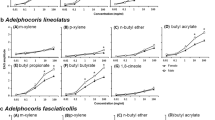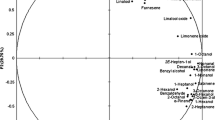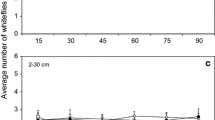Abstract
Air entrainment samples of volatiles from panicles of intact wheat, Triticum aestivum, cultivar ‘Lynx’ were collected at the ear emergence/early anthesis growth stage. In an olfactometer bioassay, both freshly cut panicles and an air entrainment sample were found to attract female orange wheat blossom midge adults, Sitodiplosis mosellana. Coupled gas chromatography-electroantennography (GC-EAG) analyses of panicle volatiles located six electrophysiologically active components. These were identified by coupled gas chromatography-mass spectrometry and coinjection with authentic standards, on polar and nonpolar GC columns, as acetophenone, (Z)-3-hexenyl acetate, 3-carene, 2-tridecanone, 2-ethyl-1-hexanol, and 1-octen-3-ol. Although none of these was active when presented individually at the levels present in the entrainment sample, acetophenone, (Z)-3-hexenyl acetate, and 3-carene were active in the olfactometer when presented at a higher dose of 100 ng on filter paper. However, the six-component blend and a blend of acetophenone, (Z)-3-hexenyl acetate, and 3-carene, in the same ratio and concentration as in a natural sample, was as attractive to female S. mosellana as the whole air entrainment sample.
Similar content being viewed by others
REFERENCES
AGELOPOULOS, N. G., HOOPER, A. M., MANIAR, S. P., PICKETT, J. A., and WADHAMS, L. J. 1999. A novel approach for isolation of volatile chemicals released by individual leaves of a plant in situ. J. Chem. Ecol.25:1411–1425.
BARNES, H. F. 1956. Gall Midges of Economic Importance: Vol. VII, pp. 57–82 Gall Midges of Cereal Crops. Crosby Lockwood, London.
BERNAYS, E. A. and CHAPMAN, R. F. 1994. Host-Plant Selection by Phytophagous Insects. Contemporary Topics in Entomology 2. Chapman & Hall, New York.
BLIGHT, M. M. 1990. Techniques for isolation and characterisation of volatile semiochemicals of phytophagous insects, pp. 281–288, inA. R. McCaffrey and I. D. Wilson (eds.). Chromatography and Isolation of Insect Hormones and Pheromones. Plenum, New York.
BLIGHT, M. M., LE METAYER, M., PHAM DELEGUE, M.-H., PICKETT, J. A., MARION-POLL, F., and WADHAMS, L. J. 1997. Identification of floral volatiles involved in recognition of oilseed rape flowers, Brassica napusby honeybees, Apis mellifera. J. Chem. Ecol.23:1715–1727.
BRUCE, T. J. and CORK, A. 2001. Electrophysiological and behavioral responses of female Helicoverpa armigerato compounds identified in flowers of African marigold, Tagetes erecta. J. Chem. Ecol. 27:1119–1131.
BUCKBAUER, G., JIROVETZ, L., WASICKY, M., and NIKIFOROV, A. 1993. Headspace and essential oil analysis of apple flowers. J. Agric. Food Chem.41:116–118.
DETHIER, V. G. 1982. Mechanism of host plant recognition. Entomol. Exp. Appl.31:49–56.
DING, H. and LAMB, R. J. 1999. Oviposition and larval establishment of Sitodiplosis mosellana(Diptera: Cecidomyiidae) on wheat (Graminae) at different growth stages. Can. Entomol.131:475–481.
FINCH, S. and COLLIER, R. 2000. Host-plant selection by insects-A theory based on "appropriate/ inappropriate" landings by pest insects of cruciferous plants. Entomol. Exp. Appl.96:91–102.
GRIES, R., GRIES, G., KHASKIN, G., KING, S., OLFERT, O., KAMINSKI, L. A., LAMB, R., and BENNETT, R. 2000. Sex pheromone of orange wheat blossom midge, Sitodiplosis mosellana. Naturwissenschaften87:450–454.
KENNEDY, J. S. 1965. Mechanisms of host plant selection. Ann. Appl. Biol.56:317–322.
KNUDSEN, J. T., TOLLSTEN, L., and BERGSTROM, G. 1993. Floral scents-A checklist of volatile compounds isolated by head-space techniques. Phytochemistry33:253–280.
LOTA, M. L., DE ROCCA SERRA, D., TOMI, F., and CASANOVA, J. 2001. Chemical variability of peel and leaf essential oils of 15 species of mandarins. Biochem. Syst. Ecol.29:77–104.
MADDRELL, S. H. P. 1969. Secretion by the Malphigian tubules of Rhodnius.The movement of ions and water. J. Exp. Biol.51:71–97.
NOJIMA, S., LINN, C., JR., and ROELOFS, W. 2003. Identification of host fruit volatiles from flowering dogwood (Cornus florida) attractive to dogwood-origin Rhagoletis pomonellaflies. J. Chem. Ecol. 29:2347–2357.
OAKLEY, J. N. 1995. Orange Wheat Blossom Midge: A Literature Review and Survey of the 1994 Outbreak. HGCA Research Review No. 28, London.
OAKLEY, J. N., CUMBLETON, P. C., CORBETT, S. J., SAUNDERS, P., GREEN, D. I., YOUNG, Y. E. B., and ROGERS, R. 1998. Prediction of orange wheat blossom midge activity and risk of damage. Crop Prot.17:145–149.
PETTERSSON, J. 1970. An aphid sex attractant. 1. Biological studies. Entomol. Scand. 1:63–73.
PICKETT, J. A. 1990. GC-MS in insect pheromone identification: Three extreme case histories, pp. 299–309, inA. R. McCaffery and I. D. Wilson (eds.). Chromatography and Isolation of Insect Hormones and Pheromones. Plenum, New York.
ROUSSIS, V., PETRAKIS, P. V., ORTIZ, A., and MAZOMENOS, B. E. 1995. Volatile constituents of needles of five Pinusspecies grown in Greece. Phytochemistry39:357–361.
TOTTMAN, D. R. and BROAD, H. 1987. Decimal code for the growth stages of cereals. Ann. Appl. Biol. 110:683–687.
VISSER, J. H. 1986. Host odour perception in phytophagous insects. Annu. Rev. Entomol.31:121–144.
VISSER, J. H. 1988. Host-plant finding by insects: Orientation, sensory input and search patterns. J. Insect Physiol.34:259–268.
WADHAMS, L. J. 1990. The use of coupled gas chromatography: Electrophysiological techniques in the identification of insect pheromones, pp. 289–298, inA. R. McCaffrey and I. D. Wilson (eds.). Chromatography and Isolation of Insect Hormones and Pheromones. Plenum, New York.
WADHAMS, L. J., ANGST, M. E., and BLIGHT, M. M. 1982. Responses of the olfactory receptors of Scolytus scolytus(F.) (Coleoptera, Scolytidae) to the stereoisomers of 4-methyl-3-heptanol. J. Chem. Ecol.8:477–492.
ZHANG, A., LINN, C., JR., WRIGHT, S., PROKOPY, R., REISSIG,W., and ROELOFS,W. 1999. Identification of a new blend of apple volatiles attractive to the apple maggot, Rhagoletis pomonella. J. Chem. Ecol.25:1221–1232.
Author information
Authors and Affiliations
Corresponding author
Rights and permissions
About this article
Cite this article
Birkett, M.A., Bruce, T.J.A., Martin, J.L. et al. Responses of Female Orange Wheat Blossom Midge, Sitodiplosis mosellana, to Wheat Panicle Volatiles. J Chem Ecol 30, 1319–1328 (2004). https://doi.org/10.1023/B:JOEC.0000037742.05022.9f
Issue Date:
DOI: https://doi.org/10.1023/B:JOEC.0000037742.05022.9f




